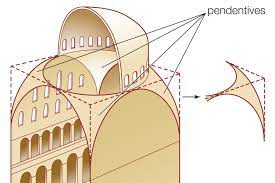Anthemius of Tralles (c.474-c.557) was mentioned as one of the builders (along with Isidore of Miletus) of the new Hagia Sophia. We know much more about him than that, however, both about his talents...and his annoying pranks.
We have an anecdote about how he avenged himself on his neighbor, Zenon, by fashioning leather tubes that he ran to the joists of an upper room of Zenon's house, where Zeno used to entertain guests. We are told that Anthemius would, by running steam through the tube, create loud noises and vibration in he room, frightening the guests into thinking there was an earthquake. Also, he would flash incredibly bright light into Zenon's eyes with a concave mirror.
Possible? Well, he did write a treatise "On burning-glasses"; we don't have the treatise anymore, but enough of it existed in 1777 to be included in a work called Concerning wondrous machines by an L. Dupuy. He apparently studied and wrote on properties of mirrors and lenses, and supposedly described a camera obscura. He explained how to construct an ellipse using string, and he wrote a book on conic sections.
This intellectual excellence ran in the family. His father, Stephanus of Tralles, was a physician with five sons. Two of them followed in their father's footsteps, Dioscorus staying in Tralles and Alexander finding fame in Rome. The rest pursued different professions. Metrodorus became a grammarian in Constantinople; Olympius became an expert in Roman jurisprudence.
Anthemius' knowledge of conic sections and parabolas would have supported both his work on optics (known to the later "Second Ptolemy" Alhazen ibn al-Haytham) and his architectural aspirations when designing the dome of the new Hagia Sophia. He was able to create what is called a "pendentive": a design that allows a dome to be built onto a square base.
His success with Hagia Sophia led to him being also chosen—probably by Emperor Justinian—to design flood defenses at Dara in northern Mesopotamia.
Showing posts with label Anthemius of Tralles. Show all posts
Showing posts with label Anthemius of Tralles. Show all posts
08 May 2013
07 May 2013
The Dome of Holy Wisdom
The greatest church in the eastern Mediterranean was the Hagia Sophia [Greek Ἁγία Σοφία - "Holy Wisdom"] in Constantinople. The first church on the site was dedicated in 360 CE, and has served as an Eastern Orthodox Cathedral, as a Roman Catholic Cathedral (from 1204, when the Fourth Crusade captured Constantinople, until 1261), as a mosque (from 1453 until 1931), and as a museum (from 1931 until the present day). It was the largest church in the world until 1520, when the Seville Cathedral was built.
When the original church was burned down during rioting,* Emperor Justinian I ordered construction of the current building in the 530s. He employed the talents of two men—we would call them "architects," although contemporary documents refer to them as "mechanics"—named Isidore of Miletus and Anthemius of Tralles. He insisted that they make a flame-proof building, so they designed it with stone and brick-and-mortar, bound in some places by iron, but with no wood anywhere. There are other dangers than fire, however.
On 7 May 558, the dome of the Hagia Sophia collapsed during an earthquake. It was rebuilt by Isidore the Younger, a nephew of Isidore of Miletus. This time, the design included 40 ribs as support, and a dome that was six meters higher. Unfortunately for the dome, the walls were constructed of less brick and more mortar, and built too quickly—they should have let the mortar cure longer in each layer before adding the next—and were consequently not as strong. The new dome also experienced collapses. The current dome contains a north section of eight ribs and a south section of six ribs from the original.
*Constantinople had two political factions, called the Blues and the Greens; their rivalry frequently became violent, resulting in property damage
When the original church was burned down during rioting,* Emperor Justinian I ordered construction of the current building in the 530s. He employed the talents of two men—we would call them "architects," although contemporary documents refer to them as "mechanics"—named Isidore of Miletus and Anthemius of Tralles. He insisted that they make a flame-proof building, so they designed it with stone and brick-and-mortar, bound in some places by iron, but with no wood anywhere. There are other dangers than fire, however.
On 7 May 558, the dome of the Hagia Sophia collapsed during an earthquake. It was rebuilt by Isidore the Younger, a nephew of Isidore of Miletus. This time, the design included 40 ribs as support, and a dome that was six meters higher. Unfortunately for the dome, the walls were constructed of less brick and more mortar, and built too quickly—they should have let the mortar cure longer in each layer before adding the next—and were consequently not as strong. The new dome also experienced collapses. The current dome contains a north section of eight ribs and a south section of six ribs from the original.
*Constantinople had two political factions, called the Blues and the Greens; their rivalry frequently became violent, resulting in property damage
Subscribe to:
Comments (Atom)


